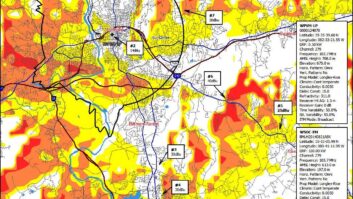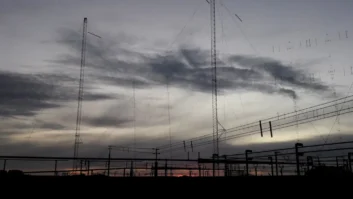Digital Radio Update – May 24, 2006
May 24, 2006 10:45 AM, By Mark Krieger, CBT
Stay up to date on the latest IBOC news, business and technology information with the twice-monthly newsletter from Radio magazine.
Index:
- Shumate Proposes HD Radio Coverage Metrics
- HD Radio Premiers at Radio Shack
- Worldspace Gets Nod for European Satellite Radio
- New HD Radio Implementation Could Spawn Subscription Radio Services
- IBOC by State: Alaska
The Simple, Hidden Joys of HD Radio
An Introduction to the New Language Surrounding HD Radio
Polk Tabletop System Slated for Summer Delivery To receive these articles twice a month in your e-mail, subscribe to the Digital Radio Update – Insight to IBOC e-newsletter. Click here to subscribe
. News Shumate Proposes HD Radio Coverage Metrics As in years past, the NAB2006 Broadcast Engineering Conference produced no shortage of intriguing presentations concerning technical matters of interest to the thousands of engineers and managers in attendance
According to the May 8 edition of the NAB’s Radio Tech Check publication, one of this years’ standout radio technology papers was delivered by Sidney Shumate, senior appraiser/engineer for BIA Financial Network, who proposes an updated system for evaluating analog and digital FM coverage.
Entitled “Rebuilding the FM Transmitter Site for HD, Step 1: Evaluating Your Coverage Area,” Shumate’s paper was part of the “Making Radio Work, Part I” session held on Sunday morning at the Las Vegas Convention Center. The presentation explored methodologies for accurately predicting an FM station’s vehicular reception area, using real world edge-of-service and prime reception contours for the analog FM stereo signal, as opposed to old-school standardized field strength contours.
Shumate’s work also covered advanced techniques for determining reliable service and edge-of-service contours for FM digital main and multicast digital audio channels by defining and measuring key digital signal performance parameters. Multicast channel service contours are of particular concern to digital broadcasters because they lack analog signal redundancy.
Among his findings, Shumate suggests the high RF noise environments in many urban areas may have a significant impact on HD Radio digital reception. Based on these and other quantifiable variables, such as real-world receiver sensitivity averages, he proposes establishing digital contour grades labeled as “digital edge,” “prime digital main” and prime digital multicast.” Shumate also proposes analog contour values based on the similar data in establishing two analog service grades labeled as “acceptable” and “prime.”
Recordings of the 2006 NAB Broadcast Engineering Conference and other conference sessions and the 2006 NAB Broadcast Engineering Conference Proceedings are available from the NAB store at www.nabstore.com
. Business HD Radio Premiers at Radio Shack Radio Shack has announced its launch of a pilot program designed to get HD Radio receivers into the hands of consumers in several major national markets, saying that the move is just a prelude to a national HD Radio roll-out at its retail outlets later this year. More than 100 of its stores in the Dallas/Fort Worth area are now stocking HD Digital Radio receivers, as are several dozen additional stores in New York City, Los Angeles, Chicago, Philadelphia, Houston and Washington, DC.
Radio Shack outlets in the pilot program will initially carry the tabletop Boston Acoustics Recepter Radio HD, with a plan to add Radio Shack-branded receivers in the fall. The company plans to expose customers to in-store, online and point-of-purchase educational support backed with employee training and in-store demonstrations. The company also plans to execute a customized radio spot campaign on all HD Digital Radio Alliance-member stations in target markets.
Radio Shack is the first major, national retail brand to become a part of the HD Digital Radio revolution, and they are doing so in an exciting and dramatic way,” said Peter Ferrara, president of the HD Digital Radio Alliance. “Having Radio Shack on board represents yet another leap forward in getting this exciting new technology into the consumer marketplace.” Worldspace Gets Nod for European Satellite Radio Worldspace has announced that its majority-owned Italian subsidiary, Worldspace Italia S.P.A. has received approval from the Italian Ministry of Communications to launch a subscription satellite radio service in Italy. The authorization grants Worldspace Italia the right to provide a subscription-based satellite radio and data service to consumers in Italy, and to use the frequency band 1,479.5MHz to 1,492MHz for the operation of the corresponding hybrid satellite/terrestrial network.
Worldspace Italia’s minority partner is New Satellite Radio S.R.L. New Satellite Radio is expected to play an integral role in operational execution of the service in Italy, including distribution arrangements, such as OEM partnerships, content supply and acquisition, and marketing.
Worldspace Italia anticipates initial service to portable and vehicular devices in 2007, using an existent satellite and a terrestrial gap-filler network to be debuted in all major cities throughout Italy, pending approval of the company’s installation plan by the Ministry. Italian subscribers will have eventual access to about 50 channels of diversified sports, talk and commercial-free music programming. New HD Radio Implementation Could Spawn Subscription Radio Services According to postings in the Pubtech mailing list, an online forum for public radio engineers, Ibiquity Digital is preparing to release a test version of HD Radio software known as “conditional access.” The software would reportedly enable broadcasters to selectively restrict consumer access to certain Secondary Program Service (SPS) channels, such as radio reading services or other specialized programming not intended for general broadcast.
The news is likely to be welcomed by broadcasters and entrepreneurs who have long envisioned a digital-based system for the distribution of premium subscription content via standard consumer receivers. Industry veterans may recall many similar enterprises that formerly used analog and low bit-rate FM subcarriers (SCA) channels for the distribution of specialized content such as Muzak, business, sports, agriculture and even paging information. Historically, access in those cases was controlled through the rental of specialized receivers whose performance was sometimes marginal.
But the fact that such a capability could be built into all new digital radios is likely to expand the economic viability of a laundry list of specialized niche audio services.
The report in Pubtech indicates that Ibiquity plans to make the software available to selected organizations as early as July for testing, but Ibiquity states that this is too soon. Actual implementation in Ibiquity-licensed OEM hardware is not expected until after 2006. IBOC Across America IBOC by State: Alaska Ibiquity has a list of stations that have licensed HD Radio technology and notes those that are on the air now. IBOC by state will look at various states and list the stations that are making the transition.
Market Station HD1 HD2 HD3 Owner Anchorage KENI 650-AM News/Talk – – Clear Channel Radio Anchorage KGOT 101.3 FM CHR – – Clear Channel Radio Juneau KTOO 104.3 FM Variety Groove Salad – Capital Community Broadcasting Ketchikan KRBD 105.9 FM Public – – Rainbird Community Broadcasting Petersburg KFSK 100.9 FM Eclectic – – Narrows Broadcasting Sitka KCAW 104.7 FM Eclectic – – Raven Radio Foundation Wrangell KSTK 101.7 FM News/Talk/AC – – Wrangell Radio Group Eye on IBOC The Simple, Hidden Joys of HD Radio Long before the terms “keyboard hacks” or “techno-geek” were coined, broadcast engineers established a reputation for uncovering the hidden capabilities of all manner of electronic equipment. So it comes as no surprise that the first front-panel explorations of Boston Acoustics’ popular HD Radio Recepter model receiver comes from Alaska Public Radio Engineer Chuck Lakaytis.
According to Lakaytis, the Recepter can actually do a number of tricks not mentioned in its manual. For example, users can lock a station into analog reception by tuning to a desired station and pushing the Alarm 1 and Alarm 2 buttons simultaneously. Users can also enter a hidden technical setup menu by tuning to a station and then holding down the clock button for 20 seconds. The list of possibilities presented for the patient explorer is seductive but alarming. One can at least be comforted that a “load default restore” command allows the user to gratefully exit the technical twilight zone.
Of particular interest is the split-mode option, which allows the user to listen to analog and main channel digital signals simultaneously. But Lakaytis advises to have earplugs ready, as the radio delivers this schizophrenic delight at full volume.
For engineers working endless overtime to convert entire broadcasting plants to this ponderous new technology, it’s comforting to know that there are still a few old-fashioned pleasures to be had from poking around the virtual interior of a humble receiver.
Thanks for sharing, Chuck. HD Radio Terminology The new language of HD Radio characterization parameters: The unique set of defining parameters for each logical channel for a given service mode. The channel encoding, interleaving, spectral mapping and diversity delay of the logical channel determine its characterization parameters.
latency: The time delay that a logical channel imposes on a transfer frame as it traverses Layer 1 of the OSI model. One of the three characterization parameters. Products Polk Tabletop System Slated for Summer Delivery Polk Audio intends to enter the arena of home HD Radio with the pending release of its I-Sonic entertainment system. More than just a tabletop receiver, the company claims the I-Sonic will marry HD Radio, a DVD player with video/CD/ MP3 capability and XM satellite radio to deliver a compact home entertainment package.
HD Radio implementation on the I-Sonic will accommodate full multicast and scrolling text display for PAD and non-PAD data, while a dual alarm clock feature will enhance the system’s versatility.
In addition to its built-in receiver/player functionality, the system provides two external audio line inputs as well as composite and S video outputs for use with the user’s Ipods and video monitors.
Polk plans to ship the I-Sonic this summer at a suggested retail price of $599. To receive these articles twice a month in your e-mail, subscribe to the Digital Radio Update – Insight to IBOC e-newsletter. Click here to subscribe
.












